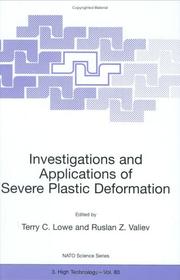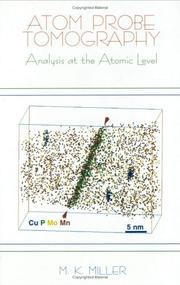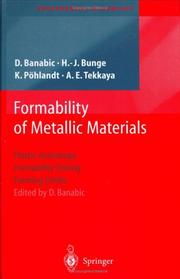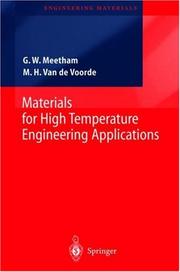| Listing 1 - 4 of 4 |
Sort by
|

ISBN: 0792362802 0792362810 9401140626 Year: 2000 Publisher: Dordrecht : Kluwer,
Abstract | Keywords | Export | Availability | Bookmark
 Loading...
Loading...Choose an application
- Reference Manager
- EndNote
- RefWorks (Direct export to RefWorks)
Material processing techniques that employ severe plastic deformation have evolved over the past decade, producing metals, alloys and composites having extraordinary properties. Variants of SPD methods are now capable of creating monolithic materials with submicron and nanocrystalline grain sizes. The resulting novel properties of these materials has led to a growing scientific and commercial interest in them. They offer the promise of bulk nanocrystalline materials for structural; applications, including nanocomposites of lightweight alloys with unprecedented strength. These materials may also enable the use of alternative metal shaping processes, such as high strain rate superplastic forming. Prospective applications for medical, automotive, aerospace and other industries are already under development.
Plasticity --- Deformations (Mechanics) --- Congresses --- Metals. --- Mechanics. --- Mechanics, Applied. --- Materials science. --- Metallic Materials. --- Theoretical and Applied Mechanics. --- Characterization and Evaluation of Materials. --- Classical Mechanics. --- Material science --- Physical sciences --- Applied mechanics --- Engineering, Mechanical --- Engineering mathematics --- Classical mechanics --- Newtonian mechanics --- Physics --- Dynamics --- Quantum theory --- Metallic elements --- Chemical elements --- Ores --- Metallurgy --- Microstructure --- Plastic deformation --- Process control

ISBN: 0306464152 1461369215 1461542812 Year: 2000 Publisher: New York (N.Y.) Kluwer Academic
Abstract | Keywords | Export | Availability | Bookmark
 Loading...
Loading...Choose an application
- Reference Manager
- EndNote
- RefWorks (Direct export to RefWorks)
The microanalytical technique of atom probe tomography (APT) permits the spatial coordinates and elemental identities of the individual atoms within a small volume to be determined with near atomic resolution. Therefore, atom probe tomography provides a technique for acquiring atomic resolution three dimensional images of the solute distribution within the microstructures of materials. This monograph is designed to provide researchers and students the necessary information to plan and experimentally conduct an atom probe tomography experiment. The techniques required to visualize and to analyze the resulting three-dimensional data are also described. The monograph is organized into chapters each covering a specific aspect of the technique. The development of this powerful microanalytical technique from the origins offield ion microscopy in 1951, through the first three-dimensional atom probe prototype built in 1986 to today's commercial state-of-the-art three dimensional atom probe is documented in chapter 1. A general introduction to atom probe tomography is also presented in chapter 1. The various methods to fabricate suitable needle-shaped specimens are presented in chapter 2. The procedure to form field ion images of the needle-shaped specimen is described in chapter 3. In addition, the appearance of microstructural features and the information that may be estimated from field ion microscopy are summarized. A brief account of the theoretical basis for processes of field ionization and field evaporation is also included.
Atom-probe field ion microscopy. --- Tomography. --- Microscopie ionique à champ et sonde atomique --- Scanographie --- Microscopie ionique à champ et sonde atomique --- Atom-probe field ion microscopy --- Tomography --- Body section radiography --- Computed tomography --- Computerized tomography --- CT (Computer tomography) --- Laminagraphy --- Laminography --- Radiological stratigraphy --- Stratigraphy, Radiological --- Tomographic imaging --- Zonography --- Computer tomography --- CT (Computed tomography) --- Cross-sectional imaging --- Radiography, Medical --- Geometric tomography --- Field ion microscopy --- Materials science. --- Metals. --- Characterization and Evaluation of Materials. --- Metallic Materials. --- Metallic elements --- Chemical elements --- Ores --- Metallurgy --- Material science --- Physical sciences

ISBN: 3540679065 3642087507 3662040131 Year: 2000 Publisher: Berlin : Springer,
Abstract | Keywords | Export | Availability | Bookmark
 Loading...
Loading...Choose an application
- Reference Manager
- EndNote
- RefWorks (Direct export to RefWorks)
After a brief introduction into crystal plasticity,the fun- damentals of crystallographic textures and plastic anisotro- py, a main topic of this book, are outlined. A large chapter is devoted to formability testing both for bulk metal and sheet metal forming. For the first time testing methods for plastic anisotropy of round bars and tubes are included. A profound survey is given of literature about yield criteria for anisotropic materials up to most recent developments and the calculation of forming limits of anisotropic sheet me- tal. Other chapters are concerned with properties of workpieces after metal forming as well as the fundamentals of the theory of plasticity and finite element simulation of metal forming processes. The book is completed by a collection of tables of international standards for formability testing and of flow curves of metals which are most commonly used in metal forming. It is addressed both to university and industrial readers.
Metal-work --- Metals --- -Metals --- -Metallic elements --- Chemical elements --- Ores --- Metallurgy --- Metalwork --- Decoration and ornament --- Manufacturing processes --- Formability --- Plastic properties --- Coloring --- Metal-work. --- Formability. --- Plastic properties. --- -Formability --- Bendability of metals --- Deformability of metals --- Formability of metals --- Workability of metals --- Metals. --- Manufactures. --- Mechanics. --- Mechanics, Applied. --- Metallic Materials. --- Manufacturing, Machines, Tools, Processes. --- Solid Mechanics. --- Applied mechanics --- Engineering, Mechanical --- Engineering mathematics --- Classical mechanics --- Newtonian mechanics --- Physics --- Dynamics --- Quantum theory --- Manufactured goods --- Manufactured products --- Products --- Products, Manufactured --- Commercial products --- Manufacturing industries --- Metallic elements

ISBN: 3540668616 3642631096 3642569382 Year: 2000 Publisher: Berlin : Springer,
Abstract | Keywords | Export | Availability | Bookmark
 Loading...
Loading...Choose an application
- Reference Manager
- EndNote
- RefWorks (Direct export to RefWorks)
coating --- materiaalonderzoek --- materiaalkennis --- legeringen --- gietijzer --- Materials sciences --- staal --- corrosie --- Metals. --- Ceramics. --- Glass. --- Composites (Materials). --- Composite materials. --- Manufactures. --- Energy systems. --- Mechanical engineering. --- Energy. --- Metallic Materials. --- Ceramics, Glass, Composites, Natural Materials. --- Manufacturing, Machines, Tools, Processes. --- Energy Systems. --- Mechanical Engineering. --- Energy, general. --- Engineering, Mechanical --- Engineering --- Machinery --- Steam engineering --- Manufactured goods --- Manufactured products --- Products --- Products, Manufactured --- Commercial products --- Manufacturing industries --- Composites (Materials) --- Multiphase materials --- Reinforced solids --- Solids, Reinforced --- Two phase materials --- Materials --- Amorphous substances --- Ceramics --- Glazing --- Ceramic technology --- Industrial ceramics --- Keramics --- Building materials --- Chemistry, Technical --- Clay --- Metallic elements --- Chemical elements --- Ores --- Metallurgy
| Listing 1 - 4 of 4 |
Sort by
|

 Search
Search Feedback
Feedback About UniCat
About UniCat  Help
Help News
News